
Presented is a patent for: facilitating cognitive attention.
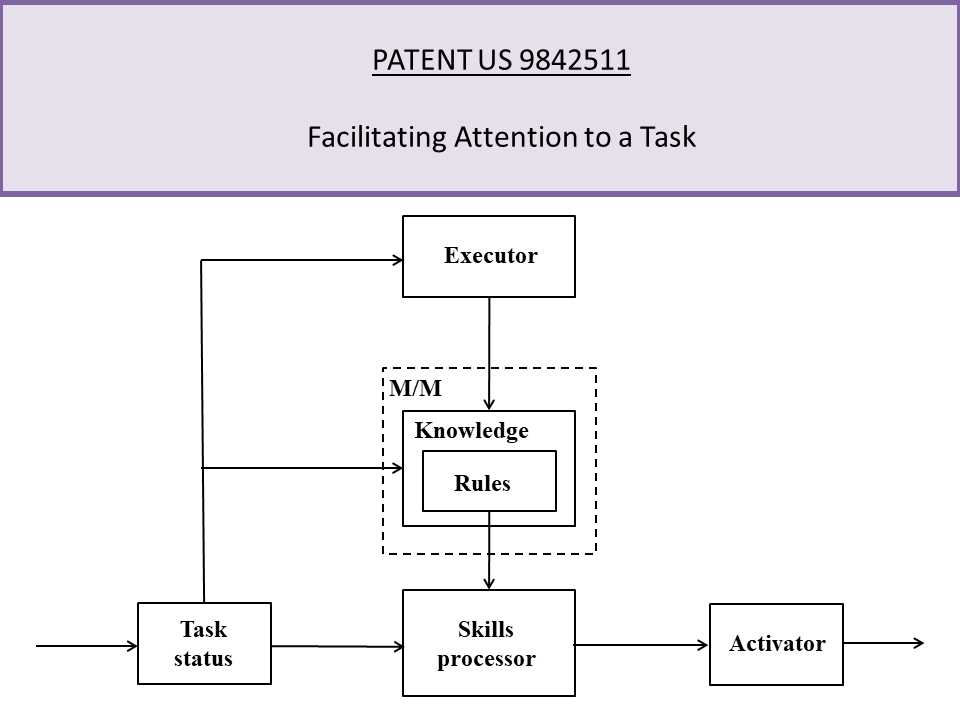
PATENT US 9842511
Invention for facilitating attention to a task by: detecting, with a sensor, one or more movements, estimating the task attention state based on the movements, determining the workload based on the estimated attention state, and determining based on the workload, the optimal format for the relay of information that best facilitates cognition. (more)
The patent follows from a skill-rules-knowledge information processing model of cognitive processes where the model consists of an Executor, task (mental) model base with Knowledge and script Rules, and a Skills processor, with task status input to the executor, task model base, and the skills processor with in turn output to an activator.
In this patent, cognition comprises reasoning, recall, and skill-based processing, a minimal set of cognitive functions with intended application to solving problems. Here, processing is the application of motor skills to the manipulation of the external environment, recall is the activation of knowledge for such processing, and reasoning is an internal process for extracting knowledge for such recall.
The activation by recall consists of linking to a schema in memory as knowledge for retrieval and transformation of such into scripts for expression by the motor-skill processing. The reasoning essentially consists of mentation on recalls toward extraction for further recall; as a process, reasoning may include dedicated internal logical and arithmetic processors as part of the mentation.
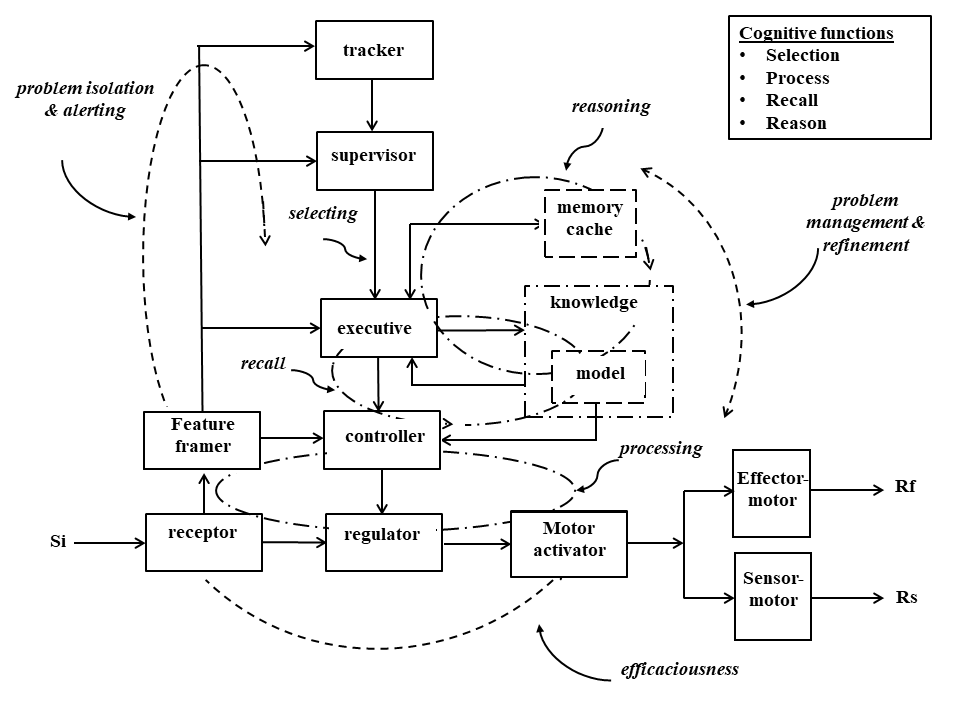
The cognition model is incorporated in the patent as a template expressing the cognitive functions for a control task as a problem, where the functions are composed of: selecting, reasoning, recall, and processing. Referring to the figure, an involvement goal is selected by the supervisor for a problem engagement, reasoning by the executive extracts a schema for consequent involvement with a mental model as a cognitive set from the knowledge base with the memory cache used as a working memory for refinement, recall by the controller transforms the schema into executable scripts with operational thresholds, and processing by the regulator constitutes execution of the scripts with the involvement means, where the controller includes a working memory cache for error assessment.
The patented approach has been applied to the estimation of cognition for a task as described in a paper: Estimating Cognition from task demands (more)
As described in the paper, the cognition is estimated from task cognitive demands and operator’s knowledge as derived from subjective questionnaires on task demands and cognitive compatibility applied to a mixed fixed-factorial design experiment on computer simulator road driving with road turn cues (audio, visual, combined, map alone). While driving, the participants replied to spoken questions (repeats, puzzles, planning, none), and reported other vehicles in the scenario, following which they rated the task demands with the Situation Awareness Rating Technique (SART) Questionnaire augmented by state measures, and their cognition with the Cognitive Compatibility (SART-CC) Questionnaire. These questionnaires by Taylor (1989, 1995) were used to measure the task cognitive demands, understanding (knowledge), attention, and attention supply state as task inputs at the vehicle user-machine interface, and the cognition levels of skill-level processing, reasoning, and recall activated for operator output.
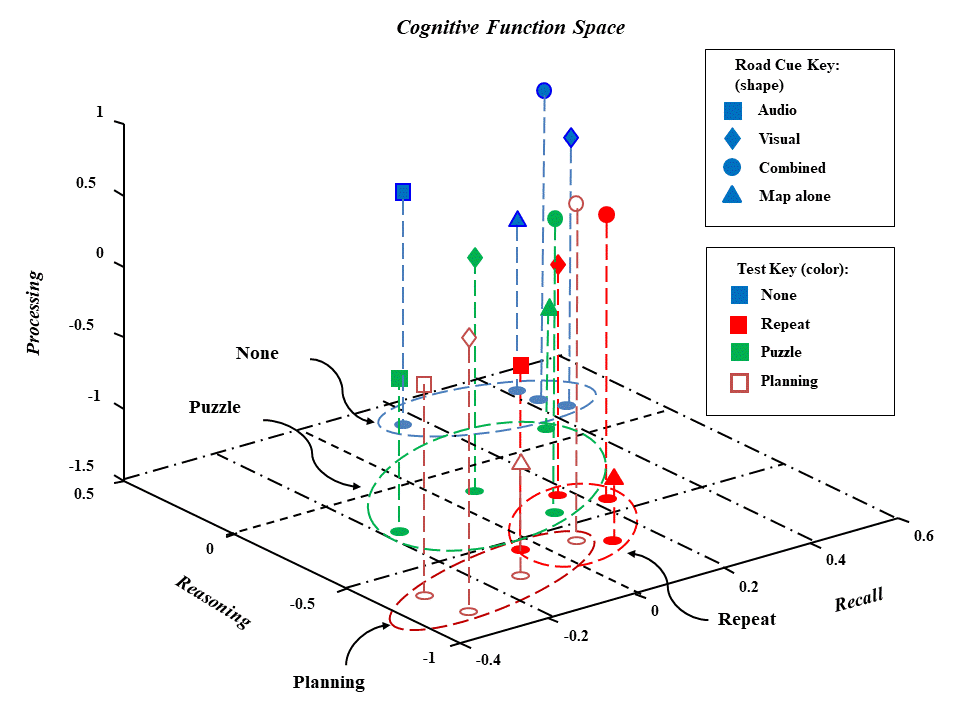
Experimental conditions of test question type and road cue method plotted in cognition function space formed by the reasoning, recall, and processing functions; the plots are the function values averaged across the subjects for the conditions. The test question types are well separated in the cognition space.
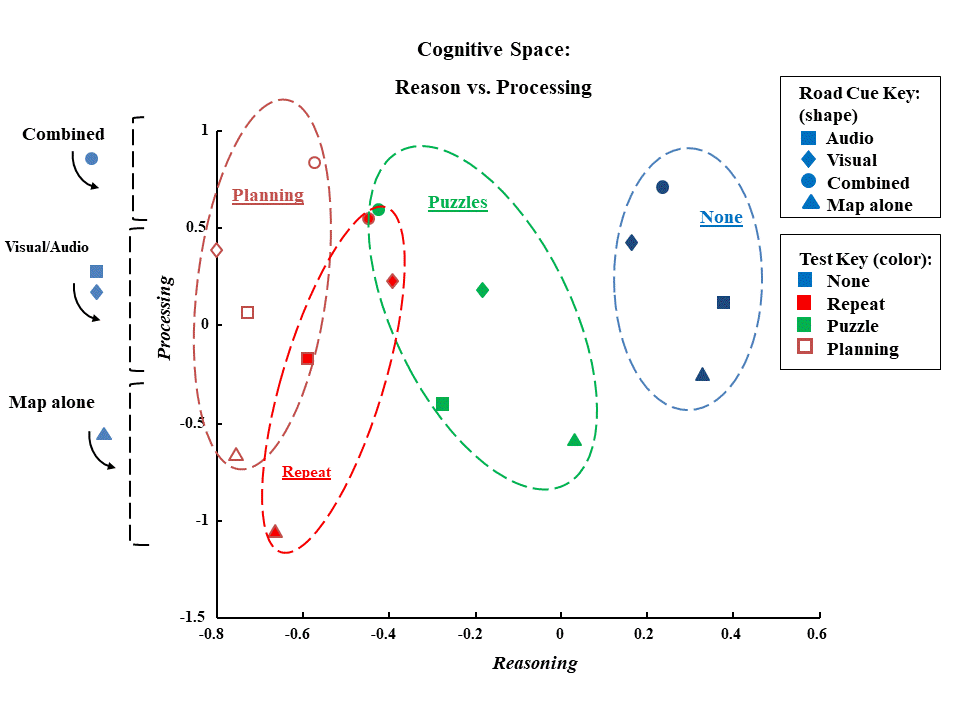
Test conditions projected to reasoning-processing plane showing little interaction between processing and reasoning; the ease of processing increases with cueing and the ease of reasoning decreases with need for planning.
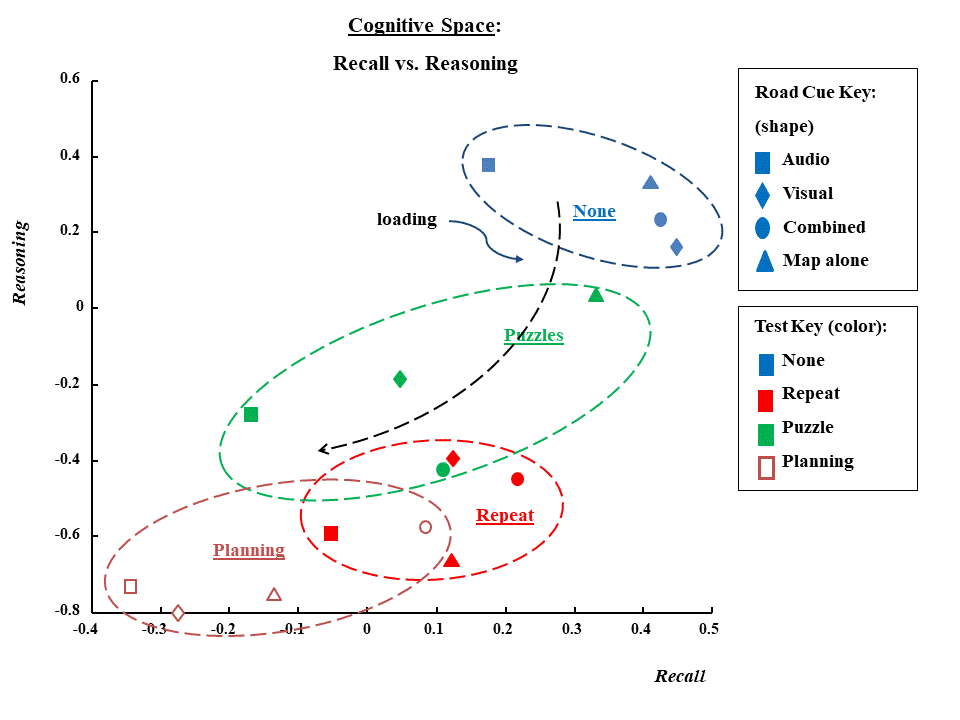
Test conditions projected to the reasoning-recall plane showing interaction between recall and reasoning with more ease of reasoning and higher recall for less planning.
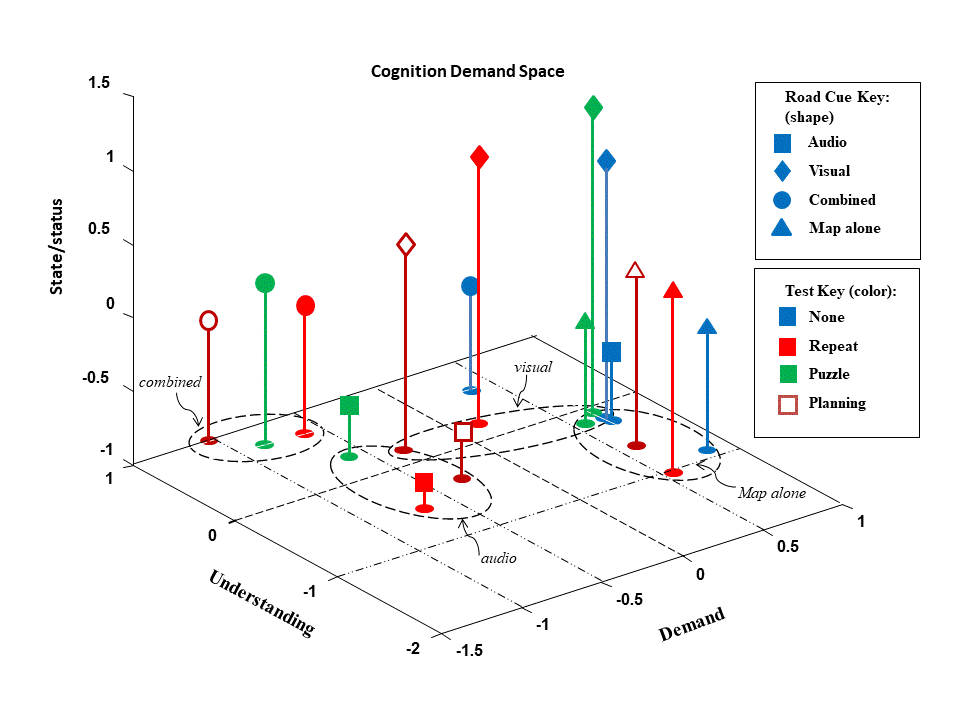
Experimental conditions of test question type and road cue method plotted in the cognition demand space formed by the demand, understanding, and attention state and status; the plots are the cognition demand values averaged across the subjects for the conditions. The plot shows that the combined visual and audio cues have high understanding, little demand, and nominal attention with the test questions; however, the cues without questions shows demand. Similarly, the audio cue has some understanding, more demand, and lower attention with the test questions; the cue without questions has high demand. The visual cue has moderate understanding and high attention, but the demand varies with the test question. Finally, the map alone cue has low understanding, high demand, but low attention regardless of the test question.

Regression factor structure coefficients plotted in the cognition demand space formed by the demand, understanding, and attention state and status; the plots are the coefficient values averaged across the subjects for the demands. Multivariate regression analysis shows that the cognition functions are significantly related as criterion variables to the cognition demand elements as predictors (p = .01 to .05). The processing function is most likely activated in low demand, high understanding, and low attention state; the recall in high demand, high understanding, and high state; and the reasoning in high demand, low understanding, and low attention state.
The patented approach has been applied further to the prediction of task performance from cognition functions as reported in the paper: Predicting performance from cognition (more)
As a continuation of the above mentioned paper, the task performance for vehicle driving and test questions along with subjective involvement, are predicted from the estimated cognition functions; the subjective involvement was collected by a Task Loading Index questionnaire administrated during the referenced experiment. As above, the cognition was estimated from the cognition demand facets of the task and the attention of the operator, where the facets include task cognitive demands and operator’s knowledge of the task as reported in the prior paper, where cognition as here composed of ease of reasoning, recall and skill-based processing functions.
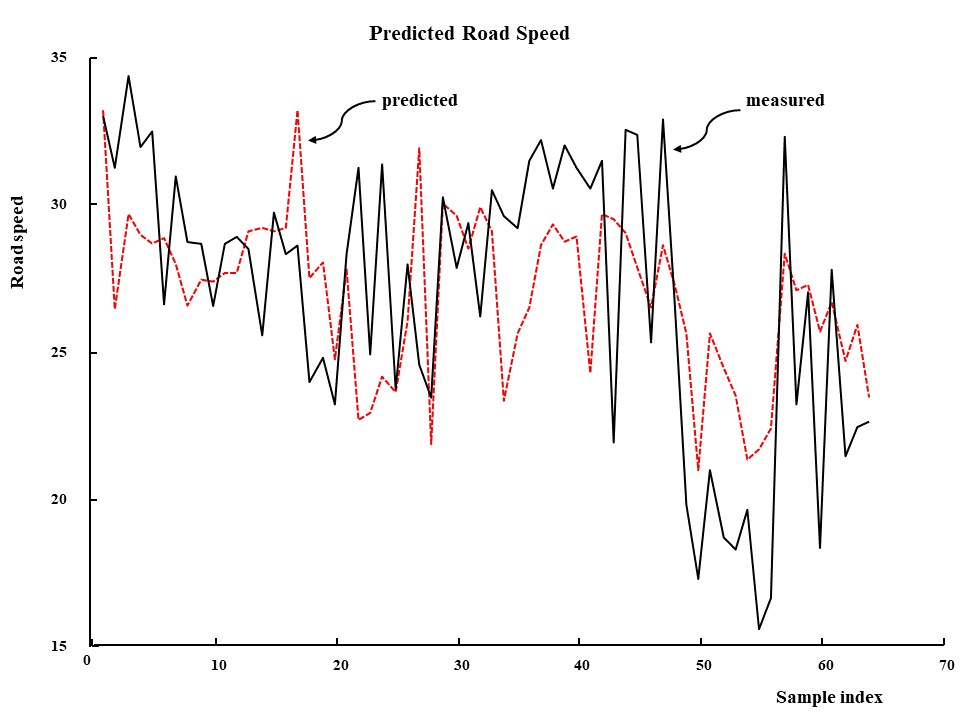
Predicted and measured road speeds plotted by participant; although not a perfect fit, a statistical test of the differences between the regressed road speed predictions and the actual speeds shows insignificant differences using a leave-one-out test for all samples except the end points in the data file. The road speed is significantly increased with increasing processing and recall function activation.
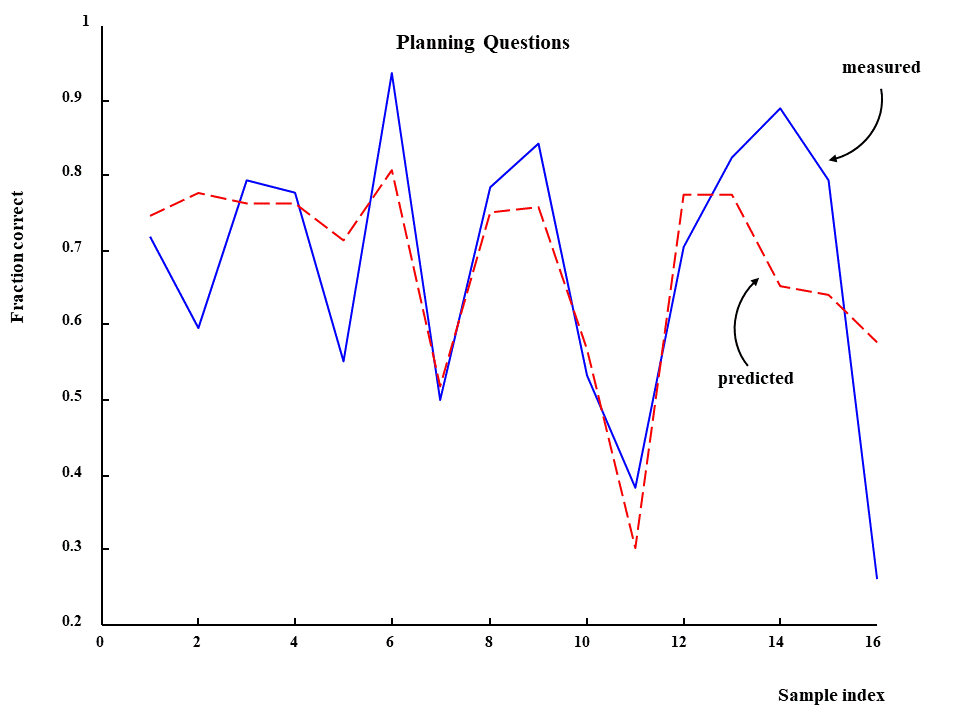
Predicted and measured fraction of correct planning question replies plotted by participant; planning is a two-step process and the accuracy of the planning significantly increases with the quadratic of the ease of reasoning as a concave function. The fraction of correct repeat replies trend to increase with a decrease in recall, and the fraction of correct puzzle replies significantly increase with an increase in ease of reasoning.
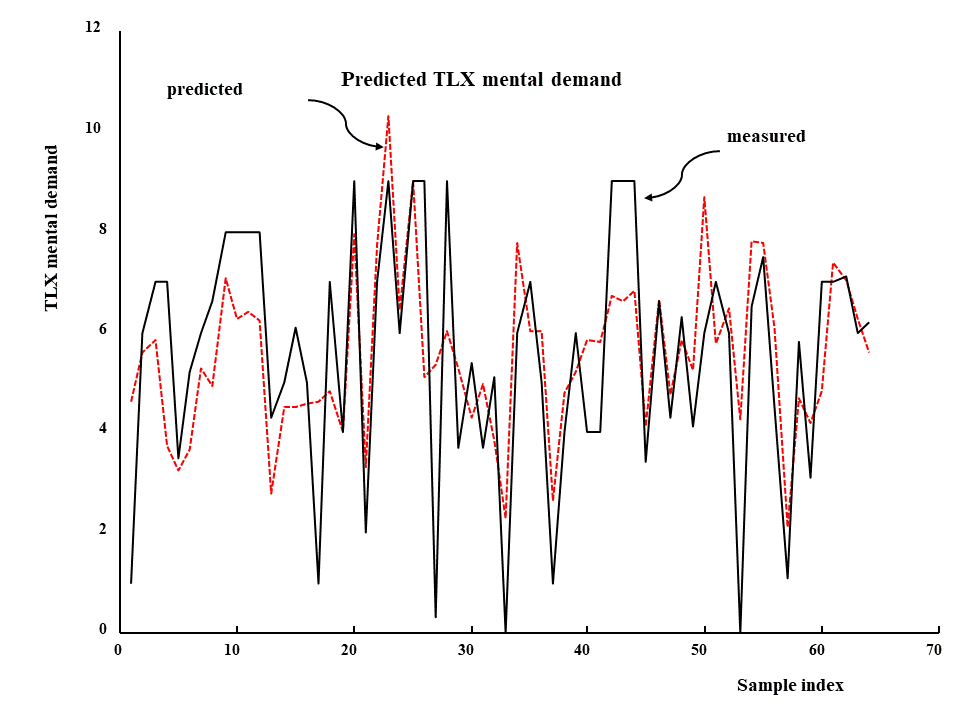
Predicted and measured mental demand Task Loading Index (TLX) scores plotted by participant; the mental demand is significantly correlated with the recall, reasoning, and processing functions. In the main, the demand and interaction dimensions significantly decrease with increasing cognition function activation.
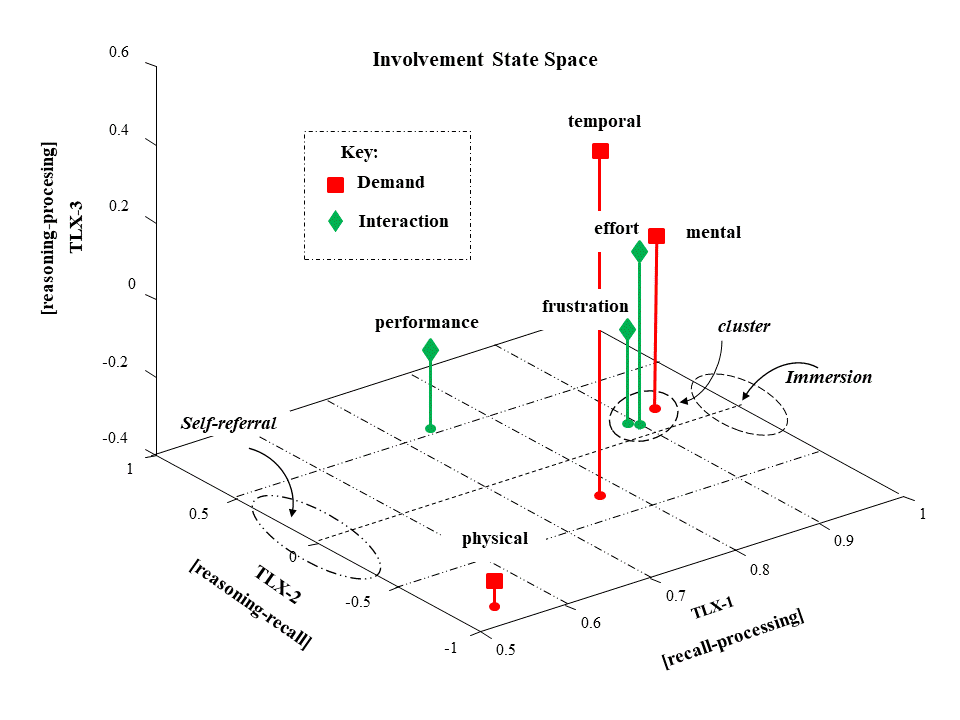
The Task Loading Index dimension measures may be plotted in a cognition involvement state space formed from involvement factors for the levels of involvement of the cognition functions that are activated together in task engagement: processing with recall, reasoning for recall, and reasoning in preparation for processing.
The involvement space is derived from a factor component-loading diagram for the six sub-scale dimension measures of the Task Loading (TLX) questionnaire reduced to three factors by a Factor Analysis. The first factor (TLX-1) separates the mental demand, effort, and frustration clustered together at one end and the physical demand and performance at the other; the second factor (TLX-2) separates the questionnaire measures for demand from those for interaction with the physical demand at one end and the performance at the other, and the third factor (TLX-3) separates out the temporal loading.
The level of cognition involvement is determined from the correlation of the loading factors with the cognition functions, the first factor (TLX-1) is significantly correlated negatively with the recall and processing functions, the second factor (TLX-2) positively with the ease of reasoning and negatively with the recall functions, and the third factor (TLX-3) negatively with the processing and the ease of reasoning functions.
Extrapolating, the first factor (TLX-1) is a measure of the recall used in processing, the second factor (TLX-2) that of the reasoning used for recall, while the third factor (TLX-3) of the reasoning used in preparing for processing. Further, dependent upon how the cognition functions are grouped in the task involvement, the task loading shows the mental demand, effort, and frustration dimension measures as clustered possibly as a task immersion region in the involvement space with little reasoning but strong recall and processing, as opposed to that of possibly self-referral with little processing but strong reasoning for recall and further in preparation for processing.
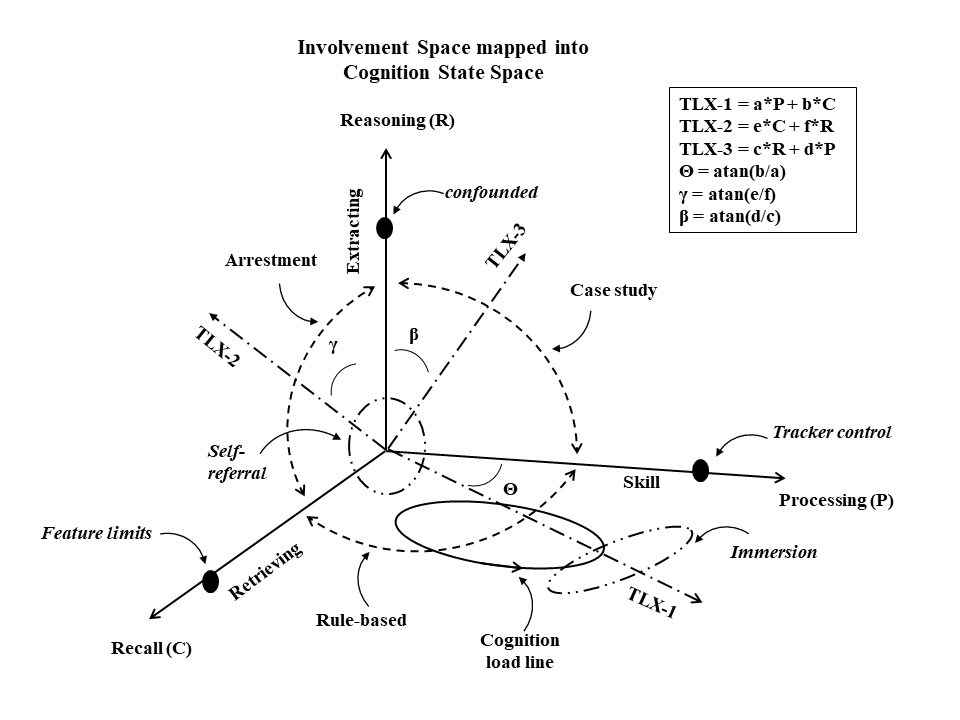
The figure shows the involvement space as possible cognition state subspaces of the cognition function space. The involvement space may be embedded in the cognition function space defined as above by the processing, reasoning, and recall functions as orthogonal axes. The mapping of the involvement space is defined by the functional dependency of the TLX factors upon the cognition functions, resulting in a cognitive state space for problem involvement. Here, plotted are possible cognition involvement states in the three-dimensional space defined by the orthonormal axes for recall, reasoning, and skill-processing. The dimensions are limited by end-states, in particular, the reasoning by being confounded, recall by capacity limited feature frame and cache refinement, and processing skills by tracker sentinel control. Here, idealistically the recall-reasoning plane corresponds to a state of arrestment of skills, the reasoning-skills processing plane to a state of memory case-study for implementing skills, and the recall-skills plane to a state of memory rule-based implementation of skills. Further, the figure shows the involvement space for the task loading mapped into the cognition space, with the TLX-1 factor axis mapped into the recall-processing plane, the TLX-2 factor axis mapped into the reasoning-recall plane, and the TLX-3 factor axis mapped into the reasoning-processing plane; the mapping may not maintain orthonormality of loading factors. The figure shows the regions for the task immersion in the recall-processing plane and the opposing self-referral along the reasoning axis of the cognition space. A state space region of interest is that of task immersion in which skill occurs in conjunction with a supportive pipelined assessment and retrieval; here, the skill flow is continual to completion. In some embodiments, this is a region of best congruity for performance and the goal state in specifying the problem schema. The task engagement may involve cognition along a cognition load line within the involvement space.